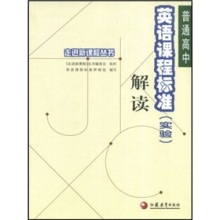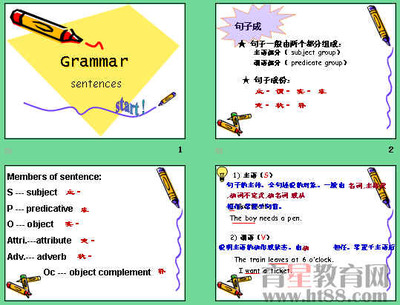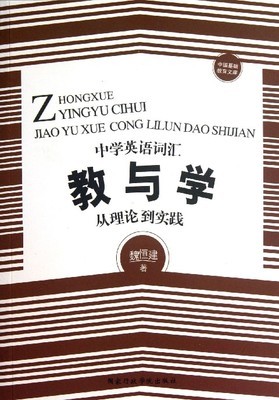1.语法形式上的一致 主语为单数形式,谓语动词用单数形式;主语为复数形式,谓语动词也用复数形式。如:
The number of the students present is 200. Jane and Mary look alike.
2.意义上一致1)主语形式虽为单数,但意义为复数,谓语动词用复数。如:The crowd were shouting.
单数形式代表复数内容的词有:people, police, cattle等。
2)主语形式为复数,而意义上却是单数,谓语动词用单数。如:The news was so surprising.
形复意单的单词有news和一些以ics结尾的学科名称,如physics,politics, economics等。
3.就近原则
即谓语动词的单、复数形式取决于最靠近它的词语。如用连词or,either…or, neither…not, not only…but also等连接的并列主语,如果一个是单数,一个是复数,谓语动词与靠近它的主语一致。如:Either your students or Mr. Wang knows this.
(二)主谓一致的应用1.名词作主语
1)某些集体名词,如family, team等作主语时,如果作为一个整体看待,谓语动词用单数形式,如果就其中一个个成员而言,谓语动词用复数形式。如:
His family is a happy one. The whole family are watching TV.
这类名词有:audience,class,club,company,crew,enemy,crowd,government,group,party,public,team等。
名词population一词的使用情况类似。“a group(crowd) of +复数名词”等短语之后的谓语动词也同样可用单数或复数,前者强调整体,后者强调各个部分。
2)某些集体名词,如people, police, cattle等,只当复数看待,谓语动词必须用复数。如:The police are searching for the thief.
3)单、复数同形的名词主语时,谓语动词应根据意义决定单、复数。如:A sheep is over there. Some sheep are over there.
4)名词所有格之后的名词被省略,这种情况一般只指商店、工厂、住宅等,作主语时,动词一般用单数。如:
The doctor’s is across the street. My uncle’s is not far from here.
常见的省略名词有:the baker’s, the barber’s, the carpenter’s, the Zhang’s等。
表示店铺的名词,一般作集体名词看待,但用作主语时,谓语动词往往用复数。如:Richardson’s have a lot of goods to sell.
5)当名词词组中心词为表示度量、距离、金额、时间、书名等复数名词时,往往可以根据意义一致的原则,把这些复数名词看作一个整体,谓语用单数形式。如:Three years has passed since then.
6)不定代词each, every, no所修饰的名词即使以and或逗号连接成多主语时,谓语动词仍用单数形式。如:
Each boy and each girl wants to go to the cinema.
7)如果主语有more than one…或many a…构成,尽管从意义上看是复数内容,但它的谓语动词仍用单数形式。如:
More than one student has read the book. Many a girl has been there.
但是,“more +复数名词+than one”结构之后,谓语动词一般多用复数形式。如:
More members than one are against your plan.
8)一些有两个部分构成的名词表示衣物或工具作主语时,谓语动词通常用复数形式,例如:glasses, clothes, trousers, shoes, compasses, chopsticks, scissors等。但如果主语用“a kind of, a pair of , a series of等加名词”构成时,谓语动词一般用单数形式。如:
A pair of shoes was on the desk.
9)this kind of book =a book of this kind(这种书),其谓语动词用单数;短语this kind of men =men of this kind =these kind of men(口语)(这一类人),但this kind of men的谓语动词用单数,men of this kind和these kind of men的谓语动词用复数,all kinds of后跟复数名词,谓语动词用复数形式。如:
This kind of men is dangerous.Men of this kind are dangerous.
10)复数形式的单、复数同形名词作主语时,按意义一致原则,作用单数意义时,谓语用单数,反之,谓语用复数。这类名词有:means(方法),works(工厂),species(种类),Chinese,Japanese等。如:
The (This) glass works was set up in 1980. (这家玻璃厂建于1980年。)The(These)glass works are near the railway station.
当它们前面有a, such a , this, that修饰时,谓语用单数;有all, such, these, those修饰时,谓语用复数,但means, no means, the means等词前没有以上修饰词时,可用作单数,也可用作复数。
11)如果名词词组中心词是all,most, half, rest等词语,所指的复数意义,谓语动词用复数形式;反之,用单数。如:
All of my classmates like music.All of the water is gone.
12)在主谓倒装的句子中,谓语动词的数应与其后的主语一致。如:Between the two windows hangs a picture.
2.由连接词连接的名词作主语 1)用and或both…and连接并列主语,谓语动词通常用复数形式。如:
Plastics and rubber never rot.Walking and riding are good exercises.
但是,并列主语如果指的是同一个人、同一事物或同一概念时,谓语动词用单数形式,这时and后面的名词没有冠词。如:
Truth and honesty is the best policy.The girl’s teacher and friend is a young doctor. To love and to be loved is great happiness.
Going to bed early and getting up early is a good habit.A knife and fork is on the table.
2)当主语后面跟有as well as, as much as, no less than, along with, with, like, rather than, together with, but, except, besides, including, in addition to等引导的词组时,其谓语动词的单、复数而定。如:
The teacher as well as the students was reading in the library.
3)以or, either…or, neither…nor, not only…but also等连接的名词(代词)作主语时,谓语动词的单复数应根据就近一致的原则。如:
Tom or his brothers are waiting in the room.Either you or he is to go.
3.代词作主语
1)名词性物主代词作主语时,既可以用作单数,也可以用作复数,这取决于它所代替的是单数还是复数。如:
Ours (Our Party) is a great party. Your shoes are black, and mine(=my shoes) are brown.
2)such, the same起指示代词作用时,应根据其所指的内容来决定单、复数。如:Such is our plan. Such are his words.
3)关系代词who, that, which等在定语从句中作主语时,其谓语动词的数应与句中先行词的数一致。如:
Those who want to go please put up your hands. Some of the energy that is used by man comes from the sun.
4)疑问代词who, what, which作主语时,谓语动词可根据说话人所要表达的意思决定单、复数。如:
Who lives next door ? It is Xiao Liu. Who live next door ? It is Zhang and Liu. What produce(s) heat ?
5)不定代词any, either, neither, none, all some, more等作主语时,有以下两种情况:
单独作主语时,视其在文中的意义,动词用单数或复数形式,例如:
Now all has been changed. All are present. either, neither单独作主语时,谓语通常用单数。
但后接of时,若of的宾语为不可数名词,动词当然用单数形式,若of的宾语为复数名词或代词时,动词可以是单数,也可以是复数,在正式文体中,单数形式的动词更常用。如:
Do(es) any of you know his address ?None of them has(have)seen the film.
4.分数、量词作主语
1)“分数或百分数+名词”构成的短语以及由“a lot of, lots of plenty of, a large quantity of, a heap of, heaps of, half of +名词”构成的短语作主语时,其谓语动词要与短语中of后面的名词的数保持一致,这是因为短语中后面的名词是中心词,而短语中前面的量词是修饰语,例如:
Lots of damage was caused by fire.
About three-fourths of the earth’s surface is covered with water. Three-fifths of the workers here are women.
和这种情况类似的还有“a number of+名词复数”,但是,“the number of +名词”的中心词却是number, 试比较:
A number of students have gone home.
The number of pages in this book is two hundred. 注意:(large)quantities of修饰可数或不可数名词,其短语作主语时,谓语动词一般用复数,例如:Quantities of food(nuts) were on the table.短语in quantity, in large quantities意为“大量”;in small quantities意为“少量”。
2)a great deal of , a large amount of修饰不可数名词,其短语作主语时,谓语动词通常用单数;large amounts of修饰不可数名词,其短语作主语时,谓语动词通常用复数,例如:
A large amount of(A great deal of)damage was done in a very short time.Large amounts of money were spent on the bridge.
3)表示数量的one and a half后,名词要用复数形式,但是其短语作主语时,谓语动词用单数形式,例如:
One and a half bananas is left on the table.
4)half of, (a) part of修饰可数名词单数及不可数名词时,谓语动词用单数,修饰可数名词复数时,谓语动词用复数。
5.名词化的形容词作主语
如果主语由“the+形容词(或过去分词)”结构担任时,谓语通常用复数,这类词有:the brave, the poor, the rich, the blind, the young, the old, the sick, the dead, the deaf and dumb, the oppressed, the injured, the wounded, the unemployed等;但也有少数的过去分词与定冠词连用时指个别,则用单数。如:
The blind study in special schools.The departed was a well-known engineer.
这类形容词或分词如果要表示个体时,就要与名词man, person或表示人的单数连和,如:an old man, a rich person, the(a)wounded soldier
6.从句作主语
1)由what引导的主语从句,谓语动词通常用单数,但所指的具体内容是复数意义时,谓语动词一般用复数形式,例如:
What we need is more time.What we need are doctors.
2)在“one of+复数名词++who/that/which”引导的从句结构中,关系代词who/that/which的先行词是靠近它的复数名词而不是one,因此,从句中的动词应该是复数形式。如:
This is one of the most interesting stories that have been told.
但是当one之前有the only等修饰语时,关系代词的先行词是one,而不是靠近它的复数名词,因此从句的动词应是单数形式。如:
She was the only one of the girls who was late.
引导学生复习好主谓一致常考题型如:
1. 单数名词(代词),不可数名词作主语时,谓语用单数形式,复数名词(代词)作主语,谓语用复数形式。
The desk is Tom’s. 这张桌子是汤姆的。 Some water is in the bottle. 一些水在瓶子里。
The students are playing football on the playground. 这些学生正在操场上踢足球。
2. many a+单数名词作主语,意义虽为“许多”,但谓语要用单数形式。Many a student has been to Shanghai. 许多学生到过上海。
3. more than one+单数名词作主语,谓语用单数。More than one student has ever been to Beijing. 不止一个学生曾经去过北京。
4. 表示时间,价格,重量,数目,长度,数学运算等的词或短语作主语时,这些通常作一个整体概念,谓语用单数形式。例如:
Two months is a long holiday. 两个月是一个长假。 Twenty pounds isn’t so heavy. 2 0英镑并不太重。
Ten miles isn’t a long distance. 1 0英里并不是一段很长的距离。 Five minus four is one. 5减4等于1。
5. 主语是each/every+单数名词+and(each/every)+单数名词时,谓语动词用单数。
Each boy and each girl has got a seat. 每个男孩和女孩都有一个座位。 Every man and every woman is at work. 每个男人
6. one and a half+复数名词作主语,谓语动词用单数形式。One and a half hours is enough. 一个半小时足够了。
7. 动词不定式,动名词作主语时,谓语动词用单数形式 To see is to believe。 Doing eye exercises is good for your eyes.
主谓一致用法在英语句子里,谓语受主语支配,其动词必须和主语在人称和数上保持一致,这就叫主谓一致。寻其规律,大致可归纳为三个原则,即语法一致、逻辑意义一致和就近一致原则。
(一)语法一致原则:语法上一致就是谓语动词和主语在单、复数形式上保持一致。
1、以单数名词或代词、动词不定式短语、动名词短语或从句作主语时,谓语动词一般用单数形式;主语为复数时,谓语动词用复数形式。
His father is working on the farm. / To study English well is not easy. / What he said is very important for us all. / The children were in the classroom two hours ago. / Reading in the sun is bad for your eyes.
注意:由what引导的主语从句,后面的谓语动词多数情况用单数形式,但若表语是复数或what从句是一个带有复数意义的并列结构时,主句的谓语动词用复数形式。
What I bought were three English books. / What I say and do is (are) helpful to you.
2、由连接词and或both ... and连接起来的合成主语后面,要用复数形式的谓语动词。如:Lucy and Lily are twins. / She and I are classmates. / The boy and the girl were surprised when they heard the news. / Both she and he are Young Pioneers.
注意:① 若and所连接的两个词是指同一个人或物时,它后面的谓语动词就应用单数形式。如:The writer and artist has come.; / ② 由and连接的并列单数主语前如果分别有no, each, every more than a (an) , many a (an)修饰时,其谓语动词要用单数形式。如:Every student and every teacher was in the room.. / No boy and no girl likes it.
3、主语为单数名词或代词,尽管后面跟有with, together with, except, but, like, as well as, rather than, more than, no less than, besides, including等引起的短语,谓语动词仍用单数形式;若主语为复数,谓语用复数形式。如:Mr Green, together with his wife and children, has come to China. / Nobody but Jim and Mike was on the playground. / She, like you and Tom, is very tall.
4、either, neither, each, every 或no +单数名词和由some, any, no, every构成的复合不定代词,都作单数看待。如:Each of us has a new book. / Everything around us is matter.
注意:① 在口语中当either或neither后跟有"of+复数名词(或代词)"作主语时,其谓语动词也可用复数。
Neither of the texts is (are) interesting.
② 若none of后面的名词是不可数名词,它的谓语动词就要用单数;若它后面的名词是复数,它的谓语动词用单数或复数都可以。
None of us has (have) been to America.
5、在定语从句时,关系代词that, who, which等作主语时,其谓语动词的数应与句中先行词的数一致。
He is one of my friends who are working hard.注意:He is the only one of my friends who is working hard.
6、如果集体名词指的是整个集体,它的谓语动词用单数;如果它指集体的成员,其谓语动词就用复数形式。这些词有family, class, crowd, committee, population, audience等。
Class Four is on the third floor. / Class Four are unable to agree upon a monitor.
注意:people, police, cattle等名词一般都用作复数。如:The police are looking for the lost child.
7、由"a lot of, lots of, plenty of, the rest of, the majority of + 名词"构成的短语以及由"分数或百分数+名词"构成的短语作主语,其谓语动词的数要根据短语中后面名词的数而定。如:There are a lot of people in the classroom. / The rest of the lecture is wonderful. / 50% of the students in our class are girls.
注意: a number of"许多",作定语修饰复数名词,谓语用复数;the number of"...的数量",主语是number,谓语用单数。
8、在倒装句中,谓语动词的数应与其后的主语一致。如:There comes the bus./ On the wall are many pictures. / Such is the result. / Such are the facts.
(二)逻辑意义一致原则:逻辑意义一致就是谓语动词的数必须和主语的意义一致(因有时主语形式为单数,但意义为复数;有时形式为复数,但意义为单数)。
1、what, who, which, any, more, all等代词可以是单数,也可是复数,主要靠意思来决定。如:Which is your bag? / Which are your bags? / All is going well. / All have gone to Beijing.
2、表示"时间、重量、长度、价值"等的名词的复数作主语时,谓语动词通常用单数形式,这是由于作主语的名词在概念上是一个整体,如:Thirty minutes is enough for the work.
3、若英语是书名、片名、格言、剧名、报名、国名等的复数形式,其谓语动词通常用单数形式。如: "The Arabian Nights"is an interesting story-book..
4、表数量的短语"one and a half"后接复数名词作主语时,其谓语动词可用单数形式(也可用复数。如:One and a half apples is (are) left on the table.
5、算式中表示数目(字)的主语通常作单数看待,其谓语动词采用单数形式。如:Twelve plus eight is twenty. / Fifty-six divided by eight is seven.
6、一些学科名词是以 -ics 结尾,如:mathematics, politics, physics 以及news, works等,都属于形式上是复数的名词,实际意义为单数名词,它们作主语时,其谓语动词要用单数形式。如:The paper works was built in 1990. / I think physics isn't easy to study.
7、trousers, glasses, clothes, shoes, 等词作主语时,谓语用复数,但如果这些名词前有a (the) pair of等量词修饰时,谓语动词用单数。如:My glasses are broken. / The pair of shoes under the bed is his.
8、"定冠词the + 形容词或分词",表示某一类人时,动词用复数。
(三)就近一致原则:在英语句子中,有时谓语动词的人称和数与最近的主语保持一致。
1、当两个主语由either ... or, neither ... nor, whether ... or ..., not only ... but also连接时,谓语动词和邻近的主语一致。如:Either the teacher or the students are our friends. / Neither they nor he is wholly right. / Is neither he nor they wholly right?
2、there be句型be动词单复数取决于其后的主语。如果其后是由and连接的两个主语,则应与靠近的那个主语保持一致。如:There are two chairs and a desk in the room..
注意:Here引导的句子用法同上。
(四)主谓一致应注意的几个问题:

A)名词作主语
1)某些集体名词(如family,team等)作主语时,如果作为一个整体看待,谓语动词用单数形式;如果就其中一个个成员而言,谓语动词用复数形式。例如:
The whole family are watching TV? His family is going to have a long journey.
这类名词有:audience,class,club,committee,company, crew,crowd,enemy,government,group,party,public,team,etc.
名词population一词的使用情况跟上述类似。例如::
The population in China is very large,and eighty percent of the population in China are farmers.
“a group(crowd)of+复数名词”等短语之后的谓语动词也同样可用单数或复数,前者强调整体,后者强调各个部分。
2)某些集体名词(如people,police,cattle,militia等)只当复数看待,谓语动词必须用复数。例如:
The police are searching for him.
3)单、复数同形的名词作主语时,谓语动词应根据意义决定单、复数。例如:
A sheep is over there, Some sheep are over there.
4)名词所有格之后的名词被省略的情况一般只指商店、工场、住宅等,作主语时,动词一般用单数。例如:
My Uncle's is not far from here. The doctor's is on the side of the street.
常见的省略名词有:the baker's,the barber's,the carpenter's,the Zhang's,etc,
表示店铺的名词一般作集体名词看待,但用作主语时,谓语 动词往往用复数。例如:
Richardson's have a lot of leather goods to sell.
5)当名词词组中心词为表示度量、距离、金额、时间、书名等复数名词时,往往可以根据意义一致的原则,把这些复数名词看作一个整体,谓语用单数形式。例如:
Five minutes is enough to do this exercise. The Selected Poems of Li Bai was published long ago.
Three years has passed.
6)不定代词each,every,no所修饰的名词即使以and或逗号连接成多个并列主语,谓语动词仍用单数形式。例如:
Each boy and each girl wants to serve the people in the future.
7)如果主语有more than one...或many a…构成,尽管从意义上看是复数内容,但它的谓语动词仍用单数形式。例如:
Many a ship has been damaged in the storm. More than one student has seen the film,
是,在“more+复数名词+than one'’结构之后,谓语词一般用复数形式。例如:
More members than one are against your plan.
8)一些由两个部分构成的名词表示衣物或工具主语时;谓语通常用复数形式,如scissors,chopsticks,compasses,shoes,trousers,clothes,glasses等。但如果主语由“a kind of ,a pair of,a series of等加名词”构成时,谓语动词一般用单数形式。例如:
A pair of shoes was on the desk .
9)this kind of book=a book of this kind(这种书),其谓语用单数;短语this kind of men=men of this kind=these kinds of men(口语)(这一类人),但this kind of men的谓语用单数,
men of this kind和these kinds of men的谓语用复数。all kinds of后跟复数名词,谓语用复数形式。例如: Men of this kind are dangerous. This kind of men is dangerous.
10)复数形式的单、复数同形名词作主语时,按意义一致的原则,作单数意义时,谓语用单数;反之,谓语用复数。这类名词有means(方法),works(工厂),species(种类),Chinese,Japanese等。例如:
The (This) glass works was set up in l970. The(These)glass works are near the railway station.
当它们前面有a,such a,this,that修饰时,谓语用单数;有all,such,these,those修饰时,谓语用复数。但“means",“no means",“the means"等词前没有以上修饰词时,可作单数,也可用作复数。
注:work作“工作”解时是不可数名词,作“著作”解时是可数名词,有单复数之分。
11)如果名词词组中心词是all,most;half,rest,part等词语,表示的是复数意义,谓语动词用复数形式;反之,用单数。例如:
All of the water is gone。 All of my classmates work hard.
12)在主谓倒装的句子中,谓语动词的数应与其后的主语一致。如: Between the two windows hangs a picture.
B)由连接词连接的名词作主语
13)用and或both...and连接并列主语,谓语动词通常用复数形式。例如:
Walking and riding are good exercises. Plastics and rubber never rot.
但是,并列主语如果指的,是同一个人、同一事物或同一概念,谓语动词用:单数形式,这时,and后面的名词没有冠词。例如:
A knife and fork is on the table. Going to bed early and getting up early is a good habit.
The girl's teacher and friend is a young doctor. Truth and honesty is the best policy。
14)当主语后面跟有as well as,as much as,no less than, along with,with, like,rather than,together with,but,except,besides,including,in addition to等引导的词组时,其谓语动词的单、复数按主语的单、复数而定。例如:
The room with its furniture was rented. The teacher as well as the students was excited.
15)以or,either...,neither...nor,not only…but also等连接的名词(代词)作主语,谓语动词的单复数应根据就近一致的原则。例Neither you nor I nor anybody else knows anything about it Either you or he is to go. Tom or his brothers are waiting in the room. C)代词作主语.’
16)名词型物主代词后的动词,既可以用单数,也可以用复数,这取决于它所代替的是单数还是复数。例如:
Ours(Our Party) is a great party. our shoes are black,mine (=my shoes) are brown.
17)such,the same起指示代词作用时,应根据其所指的内容来决定单、复数。例如:
Such are his words.Such is our plan.
8)关系代词who,that,which等在定语从句中作主语时,其谓语动词的数应与句中先行词的数一致。例如:
Some of the energy that is used by man comes from the sun. Those who want to go please you’re your names here.
19)疑问代词who,:what, which作主语时,谓语动词可根据说话人所要表达的意思决定单复数。例如:
What produce(s)heat? Which is (are) your book(s)? Who live next door? It is Zhang and Liu. Who lives next door? It is Xiao
20)不定代词.any,either,neither,none,all some,more等作主语时,有以下两种情况:
①单读用作主语时,视其在文中的意义,动词可用单数或复数形式。例如:
All are present.let's begin the meeting. Now all has been changed.
either,neither单独作主语时,谓语通常用单数。
②后接of时,若of的宾语为不可数名词,动词当然用单数形式;若of的宾语为复数名词或代词,动词可以是单数,也可以是复数;在正式文体中,单数形式的动词更常用。 None of them has(have)seen the film . Do(es) any of you know his address?
D)分数、量词作主语
21)某数词单纯表示数字作主语时,其谓语动词通常用单数形式,但是当基数词表示的不是数值而是数量时,谓语动词可用复数形式。例The billion is a large number. Twelve were boys.
英语中算术式作主语时,若是减法或除法算术式,谓语通常用单数形式;若是加法和乘法,谓语动词有时也可用复数形式。例如:
Three times five is/are fifteen. Two and (plus) two is/are four. Twelve divided by four is three. Three taken from eight leaves five.
在提问加、减、乘、除得数时,如用how much,谓语动词多用单数形式;如用how many,谓语动词多用复数形式。例如:
How many are two times five? How much is eight divided by two?
22).“分数或百分数+of+名词”构成短语,以及由“some,a lot of,lots of,plenty of,a(1arge)quantity of,the rest of,a heap of,heaps of+名词”构成短语时,其名词可以是可数名词或不可数名词。作主语时,采取就近一致的原则,其谓语动词要与短语中of后面的名词的数保持一致,这是因为短语中of后面的名词是中心词,而名词前面的量词是修饰语。例如:
A quantity of blouses were on sale. A large quantity of beer was sold.
Plenty of English books are on the shelf. Lots of damage was caused by fire.
Three-fifths of the workers here are women. About three-fourths of the earth's surface is covered with water.
23)A(great)number of,many;a few修饰可数复数名词,
其短语作主语时,谓语动词用复数;a little,much,a great deal of,a large amount of修饰不可数名词,其短语作主语时,谓语动词用单数。例如:; A large amount of(A great deal of)damage was done in a very short time. A great deal of trouble lies before us. A number of students have gone to the countryside to help with the autumn harvest.
24)(large)quantities of修饰可数
复数名词或不可数名词其短语作主语时,谓语动词一般用复数。例如:
Quantities of food (nuts) were on the table. Large amounts of money were spent on the bridge.
25)The number+可数复数名词,the amount of+不可数名词,the quantity of+可数复数名词或不可数名词构成的短
语,作主语时,谓语动词用单数,例如:
The amount of money is great. The quantity of heat in the office has not been increased.
The quantity of books in the library is amazing. The number of students in our school is increasing.
26)表示数量的one and a half 后,名词要用复数形式。但是其短语作主语时,谓语动词用单数形式。例如:
One and a half bananas is left on the table.
27)half of,(a)part of修饰可数名词单数及不可数名词时,谓语动词用单数;修饰可数名词复数时,谓语动词用复数。
E)名词化的形容词作主语,
28)如果主语由“the+形容词或过去分词)”结构充当时。谓语通常用复数。这类词有;the brave,the poor,the rich,
the blind,the young,the old, the sick,the dead,the deaf and dumb,the oppressed,the injured, the wounded, the unemployed等;但也有少数的过去分词与定冠词连用时指个别,则用单数。例如:
The departed(死者) was a well-known engineer. The blind study in special schools.
这类形容词或分词如果要表示个体时,就要与名词/man,person或表示人的单数连用如all old man,a rich person,the(a)wounded soldier F)从句作主语从句,不定式,-ing形式等做主语时,一般被看作一个整体,谓语动词应用单数。
When to leave has not been decided.
What he said and what he did were always different.(如果主语是两个(或两个以上)的名词性从句,谓语动词常用复数。)
29)由what引导的主语从句,谓语动词通常用单数;所指的具体内容若是复数意义,谓语动词一般用复数形式。例如:
What we need are doctors. What we need is more time.
30)在复数名词引导的从句结构中,关系代词的先行词是靠近它的复数名词而不是,因此,从句中的动词应该是复数形式。例如:
This is one of the most interesting questions that have been asked.
但是,当之前有等修饰时,关系代词的先行词是,而不是靠近它的复数名词,因此从句的动词应是单数形式。
she was the only one of the girls who was late for the meeting.
 爱华网
爱华网



